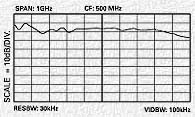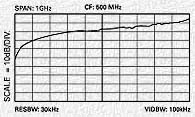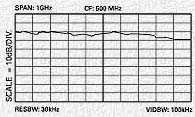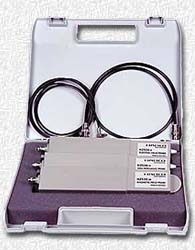|
The HZ530
is the ideal toolkit for the investigation of RF
electromagnetic fields. It is indispensable for
EMI pre-compliance testing during product
development, prior to third party testing.
The set includes 3 hand-held probes with a
built-in pre-amplifier covering the frequency range from
100kHz to over 1000
MHz.
The probes - one magnetic field probe, one
electric field probe, and one
high impedance probe - are all matched to the 50£[ inputs of
spectrum analyzers or RF-receivers. The
power can be supplied either from batteries, Ni-Cads or through a power
cord directly connected to an HM5010/5011/5012/5014 series spectrum
analyzer.
Signal feed is via a 1.5m
BNC-cable. When used in conjuction with a spectrum analyzer or a measuring
receiver, the probes can be used to locate and
qualify EMI sources, as well as evaluate EMC problems at the
breadboard and
prototype level. They enable the user to evaluate radiated fields
and perform shield effectiveness comparisons.
Mechanical screening performance and immunity tests on cables and
components are easily performed.
The H-Field Near-Field Probe
The H-Field probe provides a voltage to the connected measurement system
which is proportional to the magnetic radio frequency (RF) field strength
existing at the probe location. With this probe, circuit RF sources may be
localized in close proximity of each other. The H-field will decrease as
the cube of the distance from the source. A doubling of the distance will
reduce the H-field by a factor of eight (H = 1/d?; where d is the
distance.
In the actual use of the H-field sensor one observes therefore a rapid
increase of the probe’s output voltage as the interference source is
approached. While investigating a circuit board, the sources are
immediately obvious. It is easily noticed which component (i.e. IC) causes
interference and which does not. In addition, by use of a spectrum
analyzer, the maximum amplitude as a function of frequency is easily
identified. Therefore, one can eliminate early in the development
components which are not suitable for EMC purposes. The effectiveness of
countermeasures can be judged easily. One can investigate shields for
"leaking" areas and cables or wires for conducted interference.
The High-Impedance Probe
The high-impedance probe (Hi-Z) permits the determination of the radio
frequency interference (RFI) on individual contacts or printed circuit
traces. It is a direct-contact probe. The probe is of very high impedance
(near the insulation resistance of the printed circuit material) and is
loading the test point with only 2 pF (80£[ at 1 GHz). Thereby one can
measure directly in a circuit without significantly influencing the
relationships in the circuit with the probe.
One can, for example, measure the quantitative effectiveness of filters or
other blocking measures. Individual pins of ICs can be identified as RFI
sources. On printed circuit boards, individual problem tracks can be
identified. With this Hi-Z probe individual test points of a circuit can
be connected to the 50£[ impedance of a spectrum analyzer.
The E-Field Monopole Probe
The E-field monopole probe has the highest sensitivity of the three
probes. It is sensitive enough to be used as an antenna for radio or TV
reception. With this probe the entire radiation from a circuit or an
equipment can be measured.
It is used, for example, to determine the effectiveness of shielding
measures. With this probe, the entire effectiveness of filters can be
verified by measuring the RFI which is conducted along cables that leave
the equipment and may influence the total radiation. In addition, the
E-field probe may be used to perform relative measurements for
certification tests. This makes it possible to apply remedial suppression
measures so that any re-qualification results will be positive. In
addition, pre-testing for certification tests may be performed so that no
surprises are encountered during the certification tests.
  
Frequency Response
E-Field Probe (typical) |
Frequency Response
H-Field Probe (typical) |
Frequency Response
High Impedance Probe (typical) |
|

